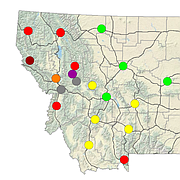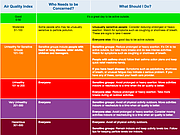Smoked out
MAUREEN DOLAN | Hagadone News Network | UPDATED 8 years, 3 months AGO
OSBURN — Labor Day was not a good day for anyone to be laboring — or doing anything else outdoors in North Idaho.
Smoke from western wildfires blanketed the region Monday, progressively degrading the air quality to some of the unhealthiest levels categorized by environmental monitors.
By the late afternoon, the air quality index in the Silver Valley had jumped to “Hazardous” levels, according to the Idaho Department of Environmental Quality’s (IDEQ) air conditions monitoring station in Pinehurst.
Earlier in the day, the air quality went from “Moderate” at noon to “very unhealthy” at 2 p.m.
The eye-stinging, sinus-irritating, visibility-limiting haze is not expected to begin improving until mid-week.
“Air quality is only expected to get worse as wind shifts bring in smoke from British Columbia and Montana fires, in addition to smoke from the Washington and Oregon Cascades,” said the National Weather Service in Spokane.
According to the Coeur d’Alene Interagency Dispatch Center, there are no wildfires in the Silver Valley as of Tuesday afternoon.
“It looks as though that every fire near us is throwing smoke our direction,” West Silver Valley Airshed Project Coordinator, Dan Smith, said.
“Mother nature is being mother nature.”
A wildfire smoke advisory was issued Tuesday afternoon by Panhandle Health District and is expected to remain in effect until conditions improve.
Smoke from wildfires is a health threat, according to the Idaho Department of Health and Welfare, because it is a mixture of gases and fine particles from burning trees and other plant materials.
When the air quality is categorized as “very unhealthy,” everyone may experience serious health effects, not just vulnerable populations like those with heart and lung conditions, children and the elderly
Air quality index values in the “hazardous” range trigger warnings for everyone with the entire population at greater risk for serious health effects.
While the Silver Valley hovers around the lower part of air quality scale, Smith and the rest of the IDEQ stress that all people should remain inside and avoid strenuous outdoor activity.
This advice is emphasized for those who fall under the “sensitive groups” classification.
In addition to these tips, residents in affected areas are advised by IDEQ to:
- Run air conditioning units and car vent systems and set them to re-circulate. For homes without a central heating and/or cooling system, use portable air purifiers to remove particles.
- Drink plenty of water. Staying hydrated helps dilute phlegm in the respiratory tract, making it easier to cough out smoke particles.
- Seek medical treatment for uncontrolled coughing, wheezing, choking, or if you have difficulty breathing once you move back indoors.
- Stay up-to-date on air quality in your community. View near real-time air quality monitoring by visiting http://airquality.deq.idaho.gov/.
Dr. Stephen Backman at Shoshone Medical Center (SMC) in Kellogg reports that, thankfully, no patients have come in with respiratory issues.
Lisa Turpin, SMC’s Marketing Manager and Medical Staff Coordinator, says that this could change though if people are not careful.
“We have a large group of people in the Silver Valley with COPD (Chronic obstructive pulmonary disease).”
If the proper precautions are not taken, the poor air quality could exacerbate this condition and others like it.
Dr. Backman also stresses that although you should never smoke in general, now is really not the time.
Shoshone County Schools may be canceling outdoor sports activities due to the air quality.
The Shoshone News-Press will release that information if and when it becomes available.
There is some good news. The weather service is forecasting cooler temperatures by the end of the week, with highs of 80 to 82 degrees on Friday and Saturday in Coeur d’Alene.
Chanse Watson, Managing Editor of the Shoshone News-Press, contributed to this article.
ARTICLES BY MAUREEN DOLAN

Daylight saving time begins today
If you arrived an hour early to everywhere you went today, you might have forgotten to move your clock back. Yep, it's daylight saving time. Daylight saving time officially ends at 2 a.m. Sunday, Nov. 5, and returns on March 10, 2024, when clocks are moved an hour forward.

Time to 'fall back'
Daylight saving time officially ends at 2 a.m. Sunday, Nov. 5 and returns March 10, 2024, when the vast majority of Americans will then “spring forward” as clocks are set an hour later.

Fires, smoke continue to affect region
Smoke from the region's wildfires continued to affect air quality Monday as firefighting response teams continued to battle multiple blazes throughout North Idaho and Eastern Washington.





